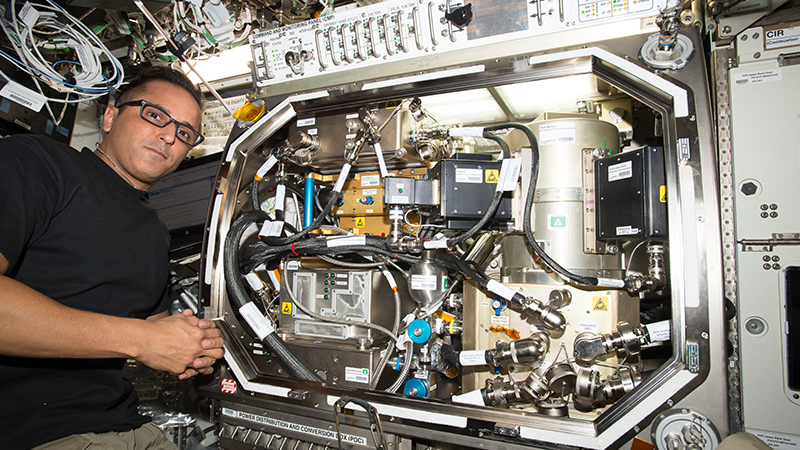Stay Up to Date
Submit your email address to receive the latest industry and Aerospace America news.
The Microgravity and Space Processes Technical Committee encourages the advancement and public awareness of low-gravity studies in physics, materials, biological sciences and related fields.
The International Space Station is increasingly relevant to a broader portion of the science community and commerce, and developments in 2017 bore out this trend.
During ISS Increments 49-51, a team at Chungnam National University in South Korea in March acquired results from the Advanced Colloids Experiment with Temperature Control, or ACE-T1, on the ISS. The ACE-T1investigated questions about the physics of colloids, which are particles suspended in a liquid. Early results show substantial structural differences between self-assembled clusters formed by using the anisotropic (convex-top) Janus particles (with hydrophilic and hydrophobic ends) in gravity and in microgravity.
Advances are important for developing self-assembling, self-moving and self-replicating technologies for potential Earth applications in the areas of self-assembly, photonics, diagnostics and drug-delivery.
The Zero Boil-Off Tank, or ZBOT, experiment was launched to ISS and installed in the Microgravity Sciences Glovebox in 2017. ZBOT explores technology and scientific modeling necessary for future long-duration space exploration missions that require very large cryogenic propellant tanks.
In news that bodes well for the future of ISS research, the National Science Foundation, in conjunction with the Center for the Advancement of Science in Space, or CASIS, in August awarded $900,000 in grants to three researchers for zero-gravity combustion research on station. The research could lead to advances in fire protection, combustion engines and biomedical technologies, according to a National Science Foundation press release.
CASIS and the National Center for Advancing Translational Sciences, part of the National Institutes of Health, in June announced five multiyear grants to examine human physiology and diseases onboard the ISS.
As agencies other than NASA put experiments on the ISS, they confirm its practical and desirable character as a research laboratory.
The commercial sector also invested in ISS science in 2017. The Target store chain, working with CASIS, announced in July the “ISS Cotton Sustainability Challenge,” which solicits proposals for biological, remote-sensing, or physical science experiments on ISS to improve the sustainability of commercial cotton crops on Earth. The winning proposal, to be announced in early 2018, will receive up to $1 million.
Following four suborbital flights with a single vehicle in 2016, including three with science payloads on board, Blue Origin appears to be on the verge of beginning commercial operations for science flights in 2017. Virgin Galactic returned to flight test operations throughout 2017. Purdue University is partnered with a local second-grade class to fly a low-cost educational payload on a pending Blue Origin sub-orbital flight. The cost of the educational flight, $8,000, is a fraction of that of K-12 sports and other activities, and thus, indicates that educational spaceflight is accessible to most schools in the country. The Next-gen Sub-orbital Researchers Conference in December 2017 is scheduled to showcase these and other advances in commercial sub-orbital spaceflight for research and education uses expected to blossom in 2018.
The NASA Flight Opportunities program in STMD Space Technology Mission Directorate continued its pursuit of spaceflight technology advances. In the past year, it awarded 12 technologies to fly in parabolic aircraft flights or commercial re-usable suborbital rockets. Technologies include regolith properties, microfluidics and manipulation of protein droplets. Earlier awards created technology payloads that are also expected to fly in 2018.
Related Posts
Stay Up to Date
Submit your email address to receive the latest industry and Aerospace America news.




